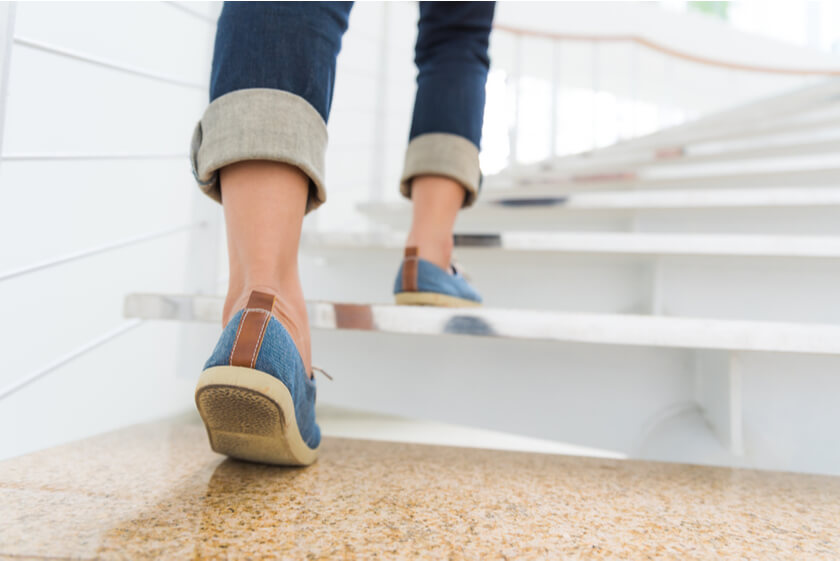Are 20,000 Steps a Day Good for Your Health?

We use walking every day as our primary form of transportation. Walking is easy as almost everyone can do it, and it has numerous health benefits.
Step trackers are increasingly popular lately, and you can monitor the number of steps you are taking from your phone. The CDC recommends that walking 10,000 steps a day is enough to stay in good shape, but most people want to hit 20,000 steps as part of their health goals.
Many personal factors such as speed, body weight, overall health, and stride affect the distance and health benefits you derive from walking 20,000 steps a day. However, any walking will benefit you regardless of the distance you intend to cover.
Benefits of 20,000 Steps a Day
An average American adult covers 3,000 to 4,000 steps a day. Some people find walking a real challenge first, but with time, they are committed to covering 20,000 steps in a day.
What benefits do you expect to reap if you are committed to adding walking to your daily routine?
#1 Great exercise for weight loss
Walking is an excellent form of exercise, and when you walk, your body burns calories, fat, and carbs. Research suggests that walking helps deal with abdominal obesity by reducing visceral (most harmful fat in the body) and belly fat.

Advertisement
People burn calories at different rates. A person’s physical activity is dependent on the height, weight, physical condition, and intensity of the activity. Your pacing also affects the calories burnt when walking.
However, to benefit from walking as a weight-loss strategy, you also need to check your diet. Committing to walking 20,000 steps a day and sticking to a healthy diet will give your body room to lose weight.
#2 Spending time outdoors
The Environmental Protection Agency states that the average American spends 93% of their lives indoors. This is regrettable as spending time outdoors is one of the effective ways to enhance your health and overall well-being.
Walking outdoors increases your mood, boosts your mental health, and gives you that dose of fresh air we all long for. Physical activity stimulates your body to release endorphins, the hormones responsible for dealing with pain and stress in the body.
A study from Harvard showed that exercise is the all-natural way to combat depression and is better than antidepressant drugs.
Besides boosting your mood, spending time outside also improves your memory, increases your energy levels, and gives you a more robust immune system.
A study from the University of Michigan showed that spending time outside and viewing pictures of nature helps significantly improve a person’s attention span and memory.
Walking is an excellent way to spend your free time outdoors and enjoy countless health benefits.
#3 A great way to challenge yourself
Challenging yourself helps you be more focused, alert, and rational in your projects. This is because the heart pumps more blood to the brain to help you perform better in the physical activities you challenge yourself to engage in.

Taking up the 20,000-steps-a-day challenge as a weight loss plan can sometimes come with difficulties. You might feel hungry more often and eat more food to satisfy your hunger.
To avoid some of the challenges you encounter in walking, you can take up the Walking.Diet plan. Walking.Diet is a customized health plan that targets specific workout needs. The guide offers walking plans, educational guides, recipes, and additional subscription perks.
The walking plan has an extensive training plan that includes pre and post-workout exercises after your walking workout. This plan also greatly assists overweight people who find it hard to handle other exercises apart from walking.
The Walking.Diet app meal plan comes with many recipes. The meals are easy to prepare, and the ingredients are easy to find in local stores.
The plan also has educational guides on walking gear, food, and nutrition. You can get other optional features such as keto desserts, cookbooks, workouts for general health for males and females, and private consultations with a nutritionist.

- Perfect for beginners
- Gets you eating healthy
- Helps you lose weight
- Keeps you motivated
- Educates
- Workouts for general health
- Offers a private consultation
#4 Improves your body’s cardiovascular system
Walking does your body a huge favor by improving your metabolism and cardiovascular system. People with heart problems can experience great benefits from walking as it increases the heart rate, strengthening the cardiovascular system.
Walking also increases your body’s metabolic rate and helps improve the way your body processes food.
#5 Better sleep quality
A public health study estimated that 50–70 million Americans have sleep disorders. About 9 million Americans over 30 take over-the-counter medicines to help them sleep.
Researchers, therefore, tried to identify one of the natural non-drug sleep inducers. They found that one of the most promising alternatives is walking.
Walking is positively associated with improved sleep quality like any other physical activity. After a long day of physical activity, you will often feel tired, but you’ll enjoy better sleep. You will quickly fall asleep and feel more refreshed and well-rested when you wake up.
How Many Calories Do 20,000 Steps Burn?
Many factors influence the number of calories you burn after walking 20,000 steps. These include physical factors such as weight, height, sex, and pacing.
For a 5’6 person, walking 20,000 steps equates to 10 miles or 16 kilometers. Walking at an average speed of 4mph burns 275 calories in an hour for a 125-pound person. A 155-pound person will burn 334 calories, and a 185-pound person will burn 400 calories.
Using steps-to-distance conversion charts, we can arrive at the following approximate conclusions of calories burnt by walking 20,000 steps:
- A 125-pound person burns 675 calories
- A 155-pound person burns 835 calories
- A 185-pound person burns 1,000 calories
These numbers are pretty impressive, and you can see visible changes in weight within two weeks if you stay consistent with the plan.
Other factors such as the difficulty of the track you follow affect the number of calories you burn. You can get good health results with proper hydration and healthy nutrition.
How Many Miles Is 20,000 Steps?
The distance you cover in 20,000 steps depends on your height or, to be specific, the length of your legs. According to the University of Wyoming, 20,000 steps equate to 16.1 kilometers or 10 miles.
For instance, a person who is 5’4 has a stride length of 2.2 feet and covers a distance of 8.5 miles after walking 20,000 steps. A person who is 5’6 has an average stride length of 2.5 feet and covers about 9.2 miles for the same distance.
20,000 Steps to Miles
20,000 steps are approximately 10 miles
How Long Does It Take to Walk 20,000 Steps?
As stated above, the average walking speed for most people is 4mph. Therefore, you will spend at least 2.5 hours covering a distance of 20,000 steps.
Just as other factors affect the number of calories burned walking 20,000 steps, other factors affect its time to cover the distance.
Factors such as fitness levels, the difficulty of the course, weight, height, and walking speed affect the time you will take to cover the distance. Walking is time-consuming as it may take up to 4 hours to cover 20,000 steps for some people.
7 Tips on How to Increase the Number of Daily Steps
To improve your daily steps, you first need to know the average steps you take daily. You can get a step tracker or use your phone to track your steps.
You can then set a daily goal and challenge yourself to increase your steps gradually. 20,000 steps a day is a lot, and starting with 20,000 steps on the very first day might overwhelm you and cause you to give up easily.
Therefore, you should gradually increase your daily average till you get to 20,000 steps a day. Below are practical strategies you can employ to meet your daily step goals.
#1 Walk to work
One lifestyle change you can adopt is walking to and from work. This might not be possible if you have a long commute to work. If you have a long commute to work, you can alight a stop earlier from your intended destination if you are using public transport.

When looking for a parking spot, most of us tend to drive around looking for the best location. You can, however, park further and cover the last remaining distance on foot. These steps may not seem as much, but they quickly mount up and increase your daily step count.
Walking to work not only helps you increase your step count, but it also helps cut the extra cost you would have spent on transport. And who knows, you might discover a new shop or fascinating corner of your neighborhood on your way.
#2 Use stairs instead of an elevator
If you want to move around more, you can make a habit of avoiding elevators and escalators and using stairs instead. Taking stairs multiple times a day in shopping malls, at work, or train stations rapidly increases your step count.

Another bonus point for using stairs is that you will benefit from walking and climbing hence burning more calories. Climbing stairs is an excellent exercise for burning fat and strengthening your muscles. It gives you more energy and is also great for your heart.
#3 Wear comfortable shoes when walking
One of the essential investments you need to make is your footwear. If you have uncomfortable walking shoes, the chances are you will not go very far and will spend more time walking.
The wrong shoe type can cause blisters, foot pain, or soft tissue injury.
You can wear your more fashionable shoes when you get to your destination, but you need comfortable shoes for long walks. Nowadays, most shoe shops offer orthopedic insoles that are pain-free and ease discomfort if you walk a lot.
#4 Schedule walking time
Scheduling regular walking time is an excellent way to develop a lasting habit. You will not feel rushed to meet your daily target by following a schedule.
You can space out your walking time instead of covering the entire distance at once. You can start with an hour in the morning, an hour at lunch break, and finally, an hour in the evening.
#5 Walk with other people
Walking with other people can turn into a joyous social occasion. It is easier to walk when you are with like-minded people. There are many platforms you can use to meet people you share the same interests with within your locality.
If you plan to meet with your best friend, you can go together for a walk instead of meeting for a coffee.
#6 Choose scenic locations for your walks
Sometimes, walking can get boring. One great idea you can use to make it enjoyable is exploring new hiking trails and locations in your locality.

Compile a list of the places you want to visit and start from there. If you’re limiting your walking around your neighborhood, you can choose different routes within the area to avoid seeing the same scenery.
You can also follow self-guided nature walks that are in many parks. When you are short on time, you can visit the nearest scenes.
#7 Use a step tracker
It is hard nowadays to see a wrist that is not adorned in a fitness watch. There are numerous effective step counters you can use on your phone.
A good step counter helps you track your goals and check your progress. You can also use them to schedule your walking sessions and form healthy habits.
A Word From RD
Walking is among the easiest and most effective forms of exercise to achieve your fitness goals. A daily 30-minute walk done 5 times a week drastically reduces a person’s risk of a sedentary lifestyle from premature death.
Walking also has numerous health benefits such as boosting energy levels, evening out blood sugar levels, improving blood circulation, improving brain function, and even reducing the chances of getting varicose veins.
Walking 20,000 steps a day also has some challenges. These include hunger and tiredness. If you are on a weight loss journey through walking, you should first consult your doctor.
Prolonged periods of inactivity are detrimental to your health. Therefore, you can spread out the walking periods to get the recommended daily exercise. Movement breaks every 30 minutes help break the dangers of inactivity to your body.
Getting active and walking is a sure way to break the inactivity cycle and achieve your health goals.
Conclusion
Taking up the 20,000-steps-a-day challenge is simple, achievable, and will take you to locations and scenery you might not have seen otherwise. You may include walking into your everyday routine with a little imagination.
The more you walk, the more amazed you will be by the positive changes in your mood and outlook on life.
The hardest part is staying consistent with your routine, as it will feel like a chore on some days. However, if you stick to the challenge, you will see positive changes in your body.

- Perfect for beginners
- Gets you eating healthy
- Helps you lose weight
- Keeps you motivated
- Educates
- Workouts for general health
- Offers a private consultation







Comments (0)